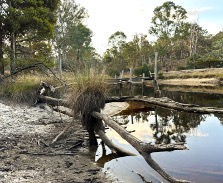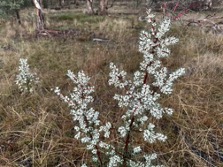Hopefully, by the time you read this, the ground will be damp, the dams full and a tinge of green will be gracing the landscape. Meanwhile, I am finding it hard to walk about this parched landscape without feeling down about the dead shrubs and the crunching, desiccated plant life underfoot. Half-empty dams are a sad sight, empty ones are horrible.
Since the huge dump of rain in later spring/early summer when we got about three months of rain in two weeks, we have had a third of the rainfall that we would expect in an average year. The rain we did have, fell in dribs and drabs, evaporating in the heat, and not wetting the profile.

The not very uplifting view of Lake Kevin in April 2025. The large sedge perched on the log was happily sitting just above the water for years. It is now suspended nearly a metre above the water, gaining sustenance from the drying mud. Will it outlive the dry spell?
Leaving rainfall deficits to one side, a more telling indication of the state of things is the grazing pressure. Our macropod numbers are up, owing to the good conditions from 2020-23, providing ample food to raise young. While we fence and net our vegetable garden from their depredations, the culinary herbs have been unprotected for 16 years, and never touched. Until this month. But now I know the palatability of all our herbs by the order in which they have been progressively defoliated by roos and wallabies. They like mint best, then tarragon, sage, oregano, marjoram, and have yet to demolish the thyme. I am hoping they do not develop a taste for these and will leave them alone when their normal forage returns.
On the positive side, our landscape is still vaguely green, owing to the unpalatable, stress-tolerant ground covers – Lomandra spp., Dianella, Carex appressa. Together with the hayed-off perennial grasses, these plants have continued to provide good cover, and will protect the soil when the next deluge arrives.
Even cheerier, are the shrub species, which are happily pushing out modest numbers of flowers, against all odds. The Urn Heath (Melichrus urceolatus) is the commonest of this group in our area, much loved by honeyeaters and rosellas.

Although it purportedly likes damp soil, the Small-fruited Hakea, (Hakea microcarpa) is flowering now.
Other local species that are currently attracting Eastern Spinebills and White-eared Honeyeaters on Gang Gang are Hakea microcarpa, Grevillea lanigera and Banksia marginata. Some of you may also have Peach Heath (Lissanthe strigosa). Not only do these plants provide a nectar source for birds, flowering also benefits insects, and the birds that feed on insects.
While the death of the pea shrubs seems ominous, I am confident that these short-lived low-growing shrubs (e.g. Pultenaea, Dillwynia, Bossiaea, and Daviesia) will regenerate well from seed when suitable rainfall arrives. Some decent falls will revive humans and nature alike.
Written by Sue McIntyre
